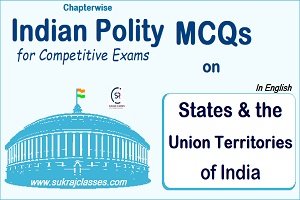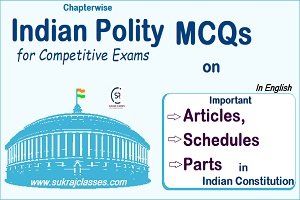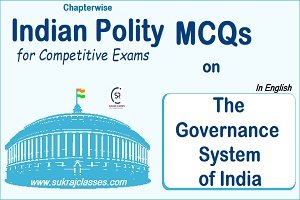
Indian Polity MCQs on “States and the Union Territories of India”
Indian Polity MCQs on “States and the Union Territories of India”, are important questions for all competitive exams i.e. UPSC, SSC, Railways, Banking, CET etc. Many questions were asked in pervious year’s exams from this topic. Let’s start the topic:
Que- 1. Power to include or admit any State into Union of India is given to…?
(A) President of India
(B) Prime Minister
(C) Parliament
(D) Supreme Court
Que- 2. According to Article 1 of Indian Constitution, India is….?
(A) Group of States
(B) Federation of States
(C) Confederation of States
(D) The Union of States
Que- 3. Indian Parliament has the power to create a new State under which of the following Constitutional provisions?
(A) Article 1
(B) Article 2
(C) Article 3
(D) Article 4
Que- 4. Who among the following has the executive power to admit a State in the Union or establish new States?
(A) Parliament
(B) Lok Sabha
(C) Political Parties
(D) Central Government
Que- 5. Which one of the following is not correct in the matter of formation of new States?
(A) Parliament may by law form a new State.
(B) Such law shall contain provisions for the amendment of the First Schedule and the Fourth Schedule of the Constitution.
(C) Such law shall be deemed to be an amendment of the Constitution for the purpose of Article 368.
(D) No Bill for enacting such law shall be introduced in the Parliament unless it has been referred to the Legislature of the States, whose areas, boundaries or name is affected.
Que- 6. Which one of the following is empowered to alter the boundaries of States under the Constitution of India?
(A) Parliament
(B) Lok Sabha
(C) President
(D) Supreme Court
Que- 7. Creation of a new state requires a ……. majority for Constitutional Amendment.
(A) Simple
(B) Two-third
(C) Three-fourth
(D) Two-third plus ratification by half of all states
Que- 8. A Bill for the purpose of creating a new State in India must be passed by …?
(A) A simple majority in Parliament and ratification by not less than two-third of the States.
(B) A simple majority in Parliament.
(C) A two-third majority in Parliament and ratification by not less than two-third of the States.
(D) None of the above.
Que- 9. Which among the following is not a ‘constitutional provision for the formation of new States’?
(A) Increase the area of any State
(B) Diminish the area of any State
(C) Alter the name of any State
(D) A State may include a Union territory
Que- 10. Union Territories in India are administered by….?
(A) The President
(B) The Lt. Governor
(C) Home Minister
(D) Administrator
Que- 11. If a new state is to be formed, which schedule of the constitution will need to be amended?
(A) Fifth
(B) Third
(C) Second
(D) First
Que- 12. How many States and Union Territories are there in India?
(A) 25 States and 7 Union Territories
(B) 28 States and 8 Union Territories (including national capital territory)
(C) 24 States and 6 Union Territory
(D) None of the above
Que- 13. How many States and UTs did the States Reorganization Commission create in 1956?
(A) 14 States and 6 UTs
(B) 17 States and 6 UTs
(C) 14 States and 8 UTs
(D) 17 States and 8 UTs
Que- 14. Which of the following is not a Union Territory?
(A) The Andaman and Nicobar Islands
(B) Jammu and Kashmir
(C) Goa
(D) Puducherry
Que- 15. In which year were the Indian States reorganized on the recommendation of the State Reorganization Commission?
(A) 1947
(B) 1951
(C) 1956
(D) 1966
States and the Union Territories of India





